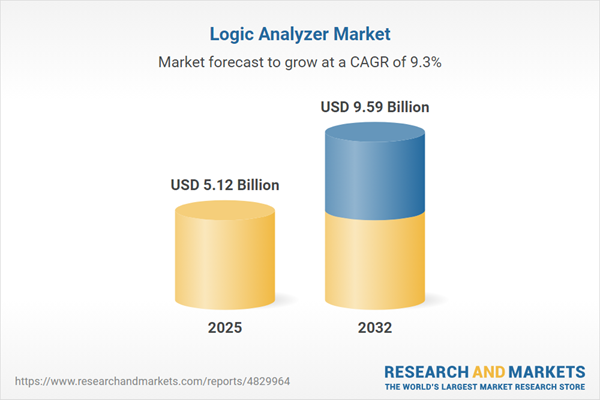Speak directly to the analyst to clarify any post sales queries you may have.
The logic analyzer market is a critical enabler for senior leaders looking to synchronize technology initiatives, enhance operational diagnostics, and ensure compliance during accelerated digital transformation. Organizations depend on robust logic analyzer solutions to align system performance with enterprise objectives, supporting strategic procurement and maintaining infrastructure reliability in complex, fast-evolving technology landscapes.
Market Snapshot: Logic Analyzer Market Trends
Experiencing steady growth, the logic analyzer market is seeing expanding adoption across key industries such as automotive, aerospace, telecommunications, and Internet of Things (IoT). As these sectors advance digitalization efforts, the integration of diverse digital protocols into sophisticated subsystems is heightening operational intricacies. Increasing demands for digitally resilient equipment are driving the need for solutions that support both regulatory compliance and comprehensive diagnostics. In response, today’s logic analyzers enable scalable, security-enhanced validation, positioning organizations to proactively manage quality assurance and maintain the integrity of modern digital infrastructure. This momentum reflects persistent investments in technology management within competitive, fast-changing environments.
Scope & Segmentation of the Logic Analyzer Market
- Product Types: Modular analyzers offer scalable solutions for wide-ranging testing needs; PC-based versions are engineered for enterprise-grade data validation workflows; portable analyzers support real-time diagnostics in field operations; standalone units enable bench-focused product development testing across all lifecycle stages.
- Protocols Supported: Coverage extends to established and next-generation digital protocols such as CAN, Ethernet, I2C, SPI, UART, and USB, delivering future-ready integration with connected and embedded systems.
- End-Use Industries: Aerospace and defense prioritize logic analyzers to satisfy stringent compliance and traceability; automotive and electronics utilize them for advanced diagnostic insight; telecommunications, healthcare, and academic settings benefit from operational flexibility and reinforced compliance assurance.
- Core Applications: Deployed for digital bus analysis, embedded system debugging, protocol validation, signal decoding, and reliability verification critical to maintaining uptime in essential digital infrastructure.
- Sales Channels: Products are accessible through authorized partners, direct supplier engagement, and digital procurement platforms, supporting a flexible sourcing environment aligned with continuity objectives.
- Regions Assessed: The analysis includes the Americas, Europe, Middle East & Africa, and Asia-Pacific, with each region exhibiting unique procurement tendencies, regulatory landscapes, and compliance demands.
- Key Vendors: Industry competition and ongoing product advancement are shaped by companies including Keysight Technologies, Tektronix, Rohde & Schwarz, Teledyne LeCroy, National Instruments, Yokogawa Electric, SIGLENT Technologies, RIGOL Technologies, Pico Technology, and Saleae LLC.
Key Takeaways for Senior Decision-Makers
- Migration to modular and integrated logic analyzer platforms enables adaptive compliance management and flexible system deployment across evolving project requirements.
- Rapid IoT expansion prompts organizations to prioritize advanced protocol validation capabilities, supporting enterprise agility and operational responsiveness.
- Embedding analytics and enhanced software functionality into logic analyzer systems streamlines internal compliance workflows and process oversight.
- Risk mitigation and effective resource planning are strengthened by selecting analyzers designed with both flexibility and compliance at their core.
- Cloud-enabled cross-functional solutions amplify workflow transparency, connecting procurement and engineering teams to expedite procurement cycles and operational execution.
- A multi-channel procurement model—spanning direct, partner, and digital avenues—builds resilience against external supply chain fluctuations and ensures sustained delivery continuity.
Tariff Impact on Supply Chains and Sourcing
Global shifts in tariff regulations require organizations to reassess sourcing and procurement processes regularly. Establishing agile supplier partnerships and adopting regionalized sourcing are proven strategies to control inventory risk and stabilize supply chains. Proactive inventory management and collaborative purchasing approaches position enterprises to respond quickly as regulatory environments shift.
Methodology & Data Sources
Findings in this report derive from direct interviews with industry executives, technical management, and compliance leaders. The methodology integrates a systematic literature review with benchmarking against established compliance standards, ensuring outcomes are actionable for decision-makers seeking operational clarity.
Why This Report Matters
- Provides a clear roadmap for integrating logic analyzer solutions into enterprise business operations, supporting strategic planning and procurement.
- Clarifies evolving market dynamics and compliance drivers to empower confident investment and risk assessment for senior leadership.
- Equips decision-makers with technology-focused insights to maintain resilience and adaptability during ongoing digital transformation.
Conclusion
Advancements in logic analyzer technologies are enabling business leaders to enhance system responsiveness and plan for future change. This report equips organizations with the insights needed to navigate the expanding challenges of digital transformation.
Additional Product Information:
- Purchase of this report includes 1 year online access with quarterly updates.
- This report can be updated on request. Please contact our Customer Experience team using the Ask a Question widget on our website.
Table of Contents
3. Executive Summary
4. Market Overview
7. Cumulative Impact of Artificial Intelligence 2025
Companies Mentioned
The companies profiled in this Logic Analyzer market report include:- Keysight Technologies, Inc.
- Tektronix, Inc.
- Rohde & Schwarz GmbH & Co. KG
- Teledyne LeCroy, Inc.
- National Instruments Corporation
- Yokogawa Electric Corporation
- SIGLENT Technologies Co., Ltd.
- RIGOL Technologies, Inc.
- Pico Technology Limited
- Saleae LLC
Table Information
| Report Attribute | Details |
|---|---|
| No. of Pages | 193 |
| Published | October 2025 |
| Forecast Period | 2025 - 2032 |
| Estimated Market Value ( USD | $ 5.12 Billion |
| Forecasted Market Value ( USD | $ 9.59 Billion |
| Compound Annual Growth Rate | 9.3% |
| Regions Covered | Global |
| No. of Companies Mentioned | 11 |









